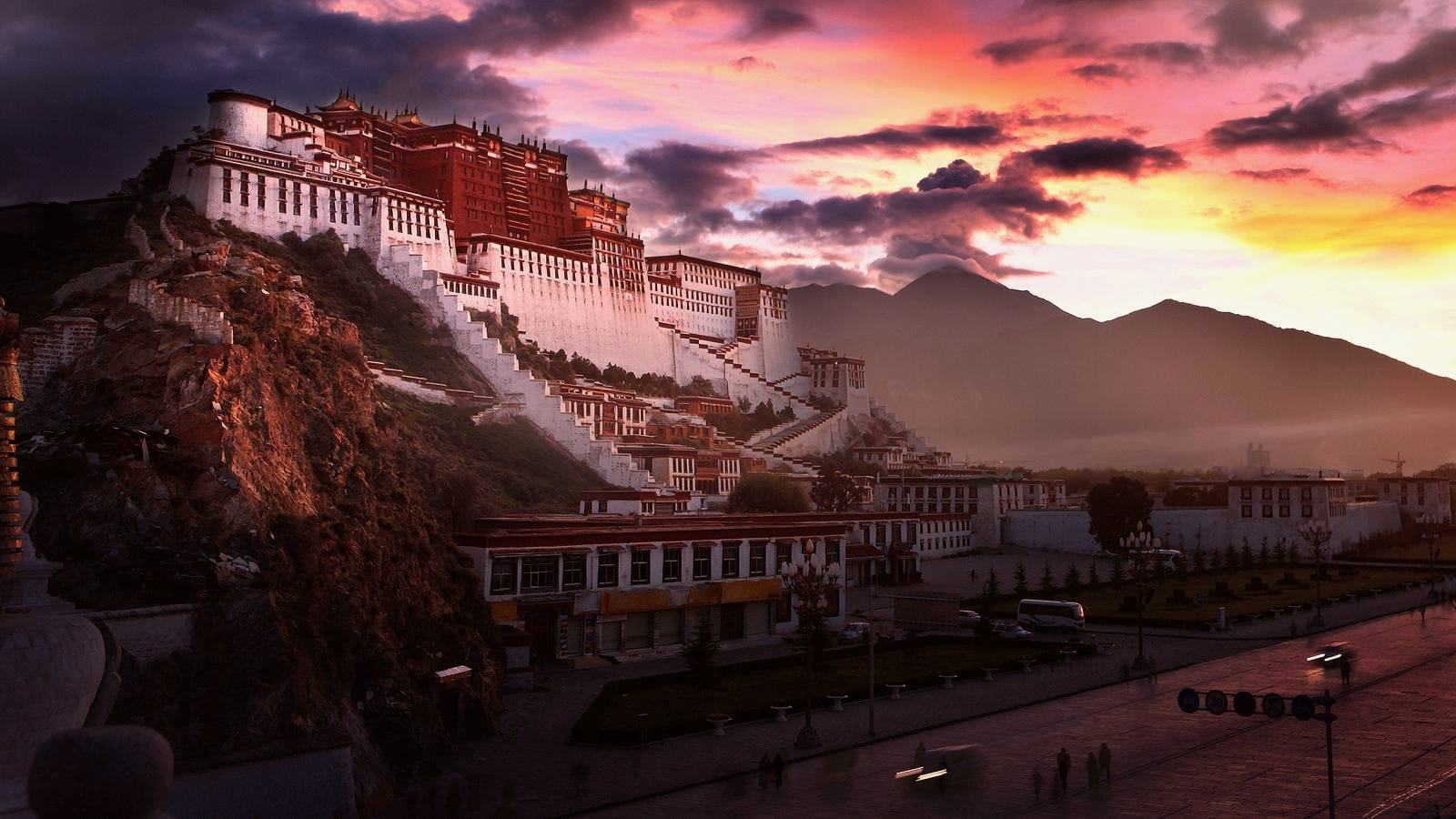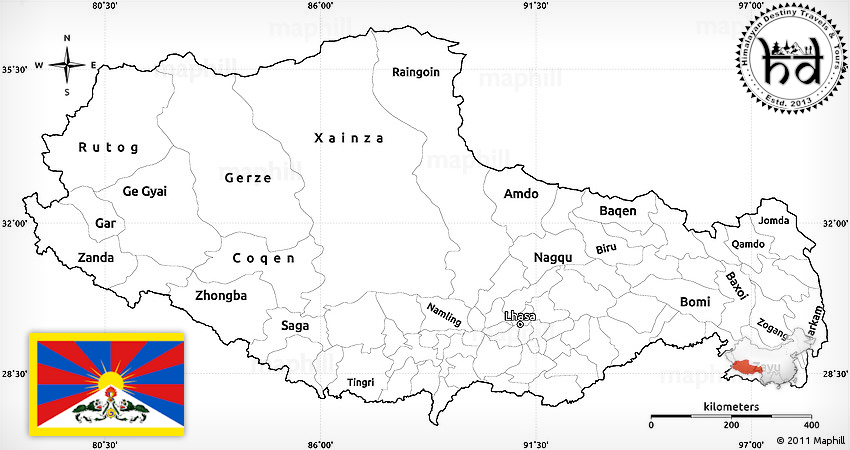About Tibet
Tibet is a region on the Tibetan Plateau in Asia. It is the traditional homeland of the Tibetan people as well as some other ethnic groups such as Monpa, Qiang and Lhoba peoples and is now also inhabited by considerable numbers of Han Chinese and Hui people. Tibet is the highest region on Earth, with an average elevation of 4,900 metres (16,000 ft). The highest elevation in Tibet is Mount Everest, earth's highest mountain rising 8,848 m (29,029 ft) above sea level.
The Tibetan Empire emerged in the 7th century, but with the fall of the empire the region soon divided into a variety of territories. The bulk of western and central Tibet (Ü-Tsang) was often at least nominally unified under a series of Tibetan governments in Lhasa, Shigatse, or nearby locations; these governments were at various times under Mongol and Chinese overlordship. The eastern regions of Kham and Amdo often maintained a more decentralized indigenous political structure, being divided among a number of small principalities and tribal groups, while also often falling more directly under Chinese rule after the Battle of Chamdo; most of this area was eventually incorporated into the Chinese provinces of Sichuan and Qinghai. The current borders of Tibet were generally established in the 18th century.
Following the Xinhai Revolution against the Qing dynasty in 1912, Qing soldiers were disarmed and escorted out of Tibet Area (Ü-Tsang). The region subsequently declared its independence in 1913 without recognition by the subsequent Chinese Republican government. Later, Lhasa took control of the western part of Xikang, China. The region maintained its autonomy until 1951 when, following the Battle of Chamdo, Tibet became incorporated into the People's Republic of China, and the previous Tibetan government was abolished in 1959 after a failed uprising. Today, China governs western and central Tibet as the Tibet Autonomous Region while the eastern areas are now mostly ethnic autonomous prefectures within Sichuan, Qinghai and other neighbouring provinces. There are tensions regarding Tibet's political status[4] and dissident groups that are active in exile.[5] It is also said that Tibetan activists in Tibet have been arrested or tortured.
The economy of Tibet is dominated by subsistence agriculture, though tourism has become a growing industry in recent decades. The dominant religion in Tibet is Tibetan Buddhism; in addition there is Bön, which is similar to Tibetan Buddhism, and there are also Tibetan Muslims and Christian minorities. Tibetan Buddhism is a primary influence on the art, music, and festivals of the region. Tibetan architecture reflects Chinese and Indian influences. Staple foods in Tibet are roasted barley, yak meat, and butter tea.
Tibet's Language
Linguists generally classify the Tibetan language as a Tibeto-Burman language of the Sino-Tibetan language family although the boundaries between 'Tibetan' and certain other Himalayan languages can be unclear. According to Matthew Kapstein:
From the perspective of historical linguistics, Tibetan most closely resembles Burmese among the major languages of Asia. Grouping these two together with other apparently related languages spoken in the Himalayan lands, as well as in the highlands of Southeast Asia and the Sino-Tibetan frontier regions, linguists have generally concluded that there exists a Tibeto-Burman family of languages. More controversial is the theory that the Tibeto-Burman family is itself part of a larger language family, called Sino-Tibetan, and that through it Tibetan and Burmese are distant cousins of Chinese.
The language has numerous regional dialects which are generally not mutually intelligible. It is employed throughout the Tibetan plateau and Bhutan and is also spoken in parts of Nepal and northern India, such as Sikkim. In general, the dialects of central Tibet (including Lhasa), Kham, Amdo and some smaller nearby areas are considered Tibetan dialects. Other forms, particularly Dzongkha, Sikkimese, Sherpa, and Ladakhi, are considered by their speakers, largely for political reasons, to be separate languages. However, if the latter group of Tibetan-type languages are included in the calculation, then 'greater Tibetan' is spoken by approximately 6 million people across the Tibetan Plateau. Tibetan is also spoken by approximately 150,000 exile speakers who have fled from modern-day Tibet to India and other countries.
Although spoken Tibetan varies according to the region, the written language, based on Classical Tibetan, is consistent throughout. This is probably due to the long-standing influence of the Tibetan empire, whose rule embraced (and extended at times far beyond) the present Tibetan linguistic area, which runs from northern Pakistan in the west to Yunnan and Sichuan in the east, and from north of Qinghai Lake south as far as Bhutan. The Tibetan language has its own script which it shares with Ladakhi and Dzongkha, and which is derived from the ancient Indian Brāhmī script.
Starting in 2001, the local deaf sign languages of Tibet were standardized, and Tibetan Sign Language is now being promoted across the country.
Geography of Tibet
All of modern China, including Tibet, is considered a part of East Asia.[58] Historically, some European sources also considered parts of Tibet to lie in Central Asia. Tibet is west of the Central China plain, and within mainland China Tibet is regarded as part of 西部 (Xībù), a term usually translated by Chinese media as "the Western section", meaning "Western China".
Tibet is often called the "roof of the world".
Tibet has some of the world's tallest mountains, with several of them making the top ten list. Mount Everest, located on the border with Nepal, is, at 8,848 metres (29,029 ft), the highest mountain on earth. Several major rivers have their source in the Tibetan Plateau (mostly in present-day Qinghai Province). These include the Yangtze, Yellow River, Indus River, Mekong, Ganges, Salween and the Yarlung Tsangpo River (Brahmaputra River).[61] The Yarlung Tsangpo Grand Canyon, along the Yarlung Tsangpo River, is among the deepest and longest canyons in the world.
Tibet has been called the "Water Tower" of Asia, and China is investing heavily in water projects in Tibet.
The Indus and Brahmaputra rivers originate from a lake (Tib: Tso Mapham) in Western Tibet, near Mount Kailash. The mountain is a holy pilgrimage site for both Hindus and Tibetans. The Hindus consider the mountain to be the abode of Lord Shiva. The Tibetan name for Mt. Kailash is Khang Rinpoche. Tibet has numerous high-altitude lakes referred to in Tibetan as tso or co. These include Qinghai Lake, Lake Manasarovar, Namtso, Pangong Tso, Yamdrok Lake, Siling Co, Lhamo La-tso, Lumajangdong Co, Lake Puma Yumco, Lake Paiku, Lake Rakshastal, Dagze Co and Dong Co. The Qinghai Lake (Koko Nor) is the largest lake in the People's Republic of China.
The atmosphere is severely dry nine months of the year, and average annual snowfall is only 18 inches (46 cm), due to the rain shadow effect. Western passes receive small amounts of fresh snow each year but remain traversible all year round. Low temperatures are prevalent throughout these western regions, where bleak desolation is unrelieved by any vegetation bigger than a low bush, and where wind sweeps unchecked across vast expanses of arid plain. The Indian monsoon exerts some influence on eastern Tibet. Northern Tibet is subject to high temperatures in the summer and intense cold in the winter.
Cultural Tibet consists of several regions. These include Amdo (A mdo) in the northeast, which is administratively part of the provinces of Qinghai, Gansu and Sichuan. Kham (Khams) in the southeast encompasses parts of western Sichuan, northern Yunnan, southern Qinghai and the eastern part of the Tibet Autonomous Region. Ü-Tsang (dBus gTsang) (Ü in the center, Tsang in the center-west, and Ngari (mNga' ris) in the far west) covered the central and western portion of Tibet Autonomous Region.
Tibetan cultural influences extend to the neighboring states of Bhutan, Nepal, regions of India such as Sikkim, Ladakh, Lahaul, and Spiti, in addition to designated Tibetan autonomous areas in adjacent Chinese provinces.
Cities, towns and villages in Tibet
There are over 800 settlements in Tibet. Lhasa is Tibet's traditional capital and the capital of Tibet Autonomous Region. It contains two world heritage sites – the Potala Palace and Norbulingka, which were the residences of the Dalai Lama. Lhasa contains a number of significant temples and monasteries, including Jokhang and Ramoche Temple.
Shigatse is the second largest city in the Tibet AR, west of Lhasa. Gyantse and Qamdo are also amongst the largest.
Other cities and towns in cultural Tibet include Shiquanhe (Ali), Nagchu, Bamda, Rutog, Nyingchi, Nedong, Coqên, Barkam, Sakya, Gartse, Pelbar, Lhatse, and Tingri; in Sichuan, Kangding (Dartsedo); in Qinghai, Jyekundo (Yushu), Machen, and Golmud; in India, Tawang, Leh, and Gangtok.
Demographics
Historically, the population of Tibet consisted of primarily ethnic Tibetans and some other ethnic groups. According to tradition the original ancestors of the Tibetan people, as represented by the six red bands in the Tibetan flag, are: the Se, Mu, Dong, Tong, Dru and Ra. Other traditional ethnic groups with significant population or with the majority of the ethnic group residing in Tibet (excluding a disputed area with India) include Bai people, Blang, Bonan, Dongxiang, Han, Hui people, Lhoba, Lisu people, Miao, Mongols, Monguor (Tu people), Menba (Monpa), Mosuo, Nakhi, Qiang, Nu people, Pumi, Salar, and Yi people.
The proportion of the non-Tibetan population in Tibet is disputed. On the one hand, the Central Tibetan Administration of the Dalai Lama accuses China of actively swamping Tibet with migrants in order to alter Tibet's demographic makeup.[83] On the other hand, according to the 2010 Chinese census ethnic Tibetans comprise 90% of a total population of 3 million in the Tibet Autonomous Region.[84] Exact population numbers probably depend on how temporary migrants are counted
Tourism in Tibet
Foreign tourists were first permitted to visit the Tibet Autonomous Region in the 1980s. While the main attraction is the Potala Palace in Lhasa, there are many other popular tourist destinations including the Jokhang Temple, Namtso Lake, and Tashilhunpo Monastery.[56] Nonetheless, tourism in Tibet is still restricted for non-Chinese passport holders and Taiwan citizens, and presently the only way for foreigners to enter is via Tibet Entry Permit. The permit can only be obtained through a travel agency in Tibet, and travel in Tibet must be arranged in a group tour, in which the group must be accompanied by a licensed tour guide at all times. Those traveling into Tibet must specify every location they want to travel within the TAR, and thus cannot travel anywhere not specified in the application. Before entering on a train, plane, or road leading into Tibet, anyone without a Chinese passport must present the Tibet Entry Permit, or they will otherwise be denied entry. Even people coming to Tibet from Nepal must have arranged for the entry permit ahead of time. People barred from obtaining the permit are journalists, diplomats, professional media photographers, and government officials.


